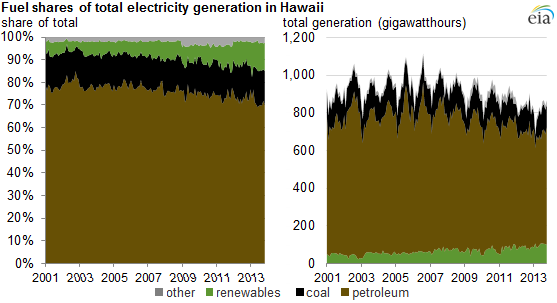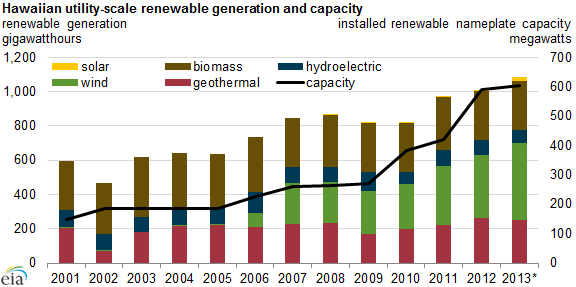Isolated Hawaii sees the cents in green
US Energy Information Administration
As an island chain lacking fossil fuels, Hawaii must import nearly all of its energy, including relatively expensive petroleum that fuels more than 70 per cent of its electricity generation. For the United States as a whole, oil fuels less than 1 per cent of electricity generation. Because electricity generation costs in Hawaii are tied closely to petroleum prices, residential electricity rates are three times the national average. Hawaii's islands are not connected by transmission lines, so each island must have enough generating capacity to meet local demand and provide emergency reserves.
Source: US Energy Information Administration and IntercontinentalExchange Inc
Faced with significant cost and reliability challenges, Hawaii's grid operators have turned to a combination of renewable sources (with lower costs than oil-fired generation), distributed generation, and energy efficiency programs that lower the overall demand for electricity in the state.
As recently as 2008, oil and coal accounted for more than 90 per cent of Hawaii's annual electric generation. The petroleum share of electric generation has been declining, from a high of 81 per cent in 2002 to 72 per cent in 2013 (through November). Meanwhile, generation from renewable sources has climbed from a 4 per cent share in 2002 to more than 12 per cent in 2013. Generation from coal comes from a single 180-megawatt facility on Oahu and has been relatively steady at 13-15 per cent of total generation each year.

Source: US Energy Information Administration, Electric Power Monthly
Total utility-scale electric generation has declined six years in a row from 2007 through 2012. This reduction is attributable to distributed generation and net metering policies that encourage electric generation from homes and businesses, mostly from solar photovoltaic installations, and increased energy efficiency measures.
Hawaii has produced renewable electricity from biomass, geothermal, and run-of-river hydroelectric sources for many years, although recent wind and solar capacity additions have resulted in large increases in renewable electricity production. In 2012, wind accounted for 36 per cent of total utility-scale renewable generation in Hawaii, a contribution that rose to 42 per cent in 2013 (through November). This increase followed the completion of three large wind projects in mid- to late-2012 (Kaheawa Phase II-21 MW, Kawailoa Wind-69 MW, and Auwahi Wind-21 MW). Utility-scale solar generation has increased more than fivefold from full-year 2012 to 2013 but still accounts for less than 2 per cent of utility-scale renewable generation in Hawaii. Utility-scale data understate total solar generation in Hawaii because totals do not include the much larger output from small-scale solar power installations.
Hawaii's installed renewable nameplate capacity in 2013 was just over 600 MW, more than triple the amount that existed in 2005. Nearly 57 MW of additional renewable capacity is currently under construction and slated to enter service in 2014, with many more projects planned for later years.

Source: US Energy Information Administration and Ventyx (Note: *2013 data are through November).
In 2008, the state began the Hawaii Clean Energy Initiative with the US Department of Energy. The partnership's objective is for Hawaii to produce 70 per cent of its electricity from clean energy by 2030 through a combination of increased renewable energy production (40 per cent of total generation) and energy efficiency (30 per cent, or a reduction in electricity demand of 4300 GWh). In addition to electricity-generating technologies, other technologies such as solar water heating and sea-water district cooling systems can be used to meet the reduction targets.
A study conducted in 2008-09 by Booz Allen Hamilton concluded that the 70 per cent goal was achievable and that Hawaiians would save money if the average price of crude oil stayed above $US65-$US85 per barrel from 2008 through 2030.
Originally published on the US EIA's Today in Energy. Reproduced with permission.

















